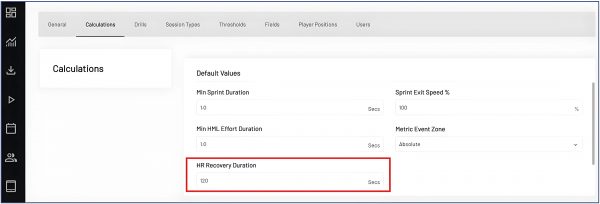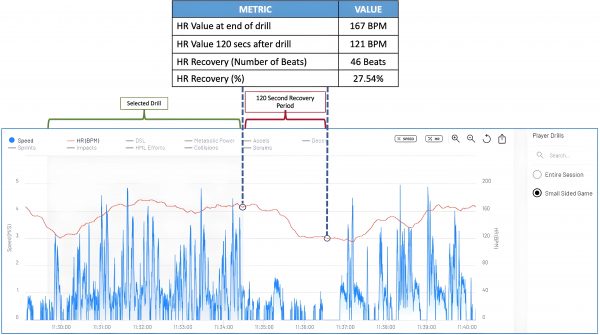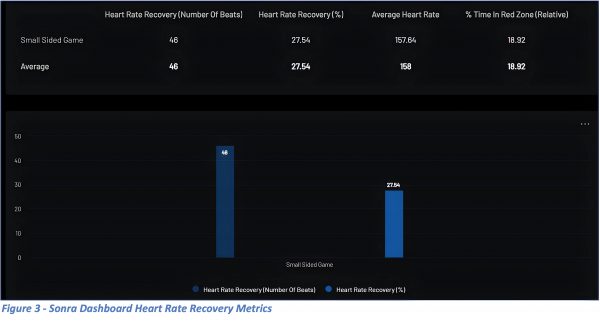
25 Apr STATSports Add New Heart Rate Recovery Metrics To Improve Internal Load Monitoring
INTRODUCTION
In the ever-evolving landscape of athlete and individual performance monitoring, staying at the forefront of technological advancements is paramount.
To consolidate our position in the vanguard of that innovation, we have introduced two new metrics to our Sonra software system: Heart Rate Recovery (Number of Beats) and Heart Rate Recovery (%).
These metrics offer practitioners insights into cardiovascular health, training effectiveness, and player physical adaptations.
Understanding Heart Rate Recovery Metrics:
Heart Rate Recovery (Number of Beats)
This metric quantifies the number of beats by which an individual’s heart rate decreases during a specified recovery period following exercise.
It provides a quantifiable measure of how much the heart rate decreases in a pre-determined period of time post-exertion.
Formula:
Heart Rate Value (At Drill End Time) – Heart Rate Value (After Recovery Duration Period From Drill End)
Heart Rate Recovery (%)
Complementing the absolute measure of heart rate recovery, this metric expresses the recovery as a percentage of the heart rate value recorded at the end of a selected exercise. It offers a standardized assessment of recovery efficiency.
Formula:
[Heart Rate Recovery (Number of Beats) / Heart Rate Value (At Drill End Time)] x 100
Within Sonra, the default heart rate recovery duration is 120 seconds. This is fully customisable for the end user in the settings page, allowing them to choose their desired time window. Users can edit this according to their preference which may be 30, 60, 90 or 180 seconds etc.
This is customisable in the Sonra Settings page in the following location: Settings > Calculations > Default Values

Figure 1. Customisable HR Recovery Duration
Example scenario
A player’s heart rate at the end of a 5 minute small sided game drill is 167 beats per minute (BPM) and after 120 seconds the heart rate has lowered to 121 BPM. The software will calculate heart rate recovery metrics as follows:
Heart Rate Recovery (Number of Beats):
Heart Rate Value (At Drill End Time) – Heart Rate Value (After Recovery Duration Period From Drill End)
167 BPM – 121 BPM = 46 Beats
Heart Rate Recovery (%):
[Heart Rate Recovery (Number of Beats) / Heart Rate Value (At Drill End Time)] * 100
(46 Beats / 167 BPM) * 100 = 27.54%

Figure 2. Sonra Activity Graph Heart Rate Recovery Metric Calculation

Practical Applications:
- Training Intensity Management: Coaches and trainers can use these metrics to fine-tune training programs based on individualized responses to exercise. By monitoring heart rate recovery, practitioners can adjust training intensity, volume, and recovery protocols to optimize performance gains while minimizing the risk of overtraining and injury.
- Performance Assessment: Heart rate recovery metrics serve as objective markers of cardiovascular fitness and adaptation to training. Tracking changes in recovery patterns over time allows practitioners to gauge the efficacy of training interventions, identify areas for improvement, and progress toward performance goals.
- Early Warning System: Abnormalities in heart rate recovery may signal underlying health issues or excessive stress on the body. By flagging deviations from expected recovery patterns, practitioners can intervene early to mitigate risks, prevent setbacks, and promote long-term health and performance sustainability.
- Recovery Strategy Optimization: Post-exercise recovery strategies play a crucial role in enhancing recovery and preparing the body for subsequent bouts of exercise. Heart rate recovery metrics enable practitioners to evaluate the effectiveness of recovery interventions, such as active or passive recovery protocols and hydration in facilitating timely physiological recovery.
Conclusion:
Incorporating Heart Rate Recovery (Number of Beats) and Heart Rate Recovery (%) metrics into our software system empowers practitioners with actionable data to elevate performance monitoring and optimization strategies.
These metrics provide a window into the body’s response to exercise and recovery, unlocking new opportunities for personalized performance enhancement and player monitoring.
Embrace the power of physiological insights and propel your athletes and individuals toward their peak potential with our innovative monitoring solutions.